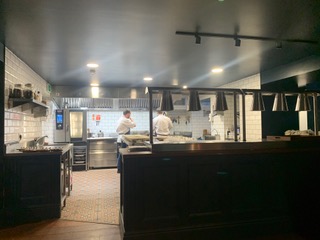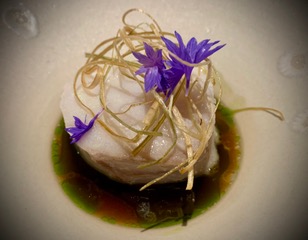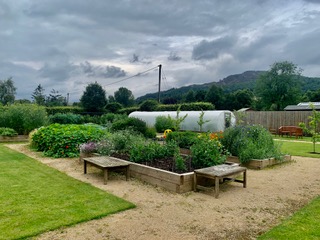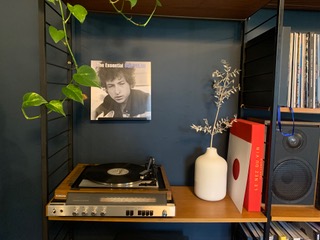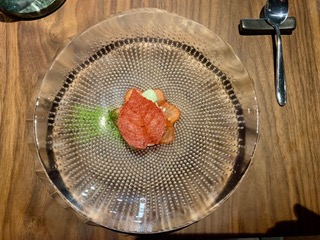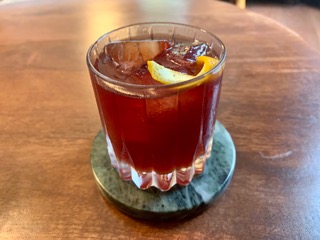Killiecrankie House by Cate Devine
- Cate Devine

- Aug 6, 2024
- 4 min read

Turning off the old A9, beyond historic Pitlochry and Dunkeld and the site of a certain famous 17th-century battle, and down a sweeping driveway, you find a picture-postcard vision of traditional Scotland: a secluded whitewashed 19th-century former manse surrounded by majestic ancient woodland and set within a delightful cottage garden.
But at Killiecrankie House appearances can be deceptive. A couple of beehives, a large polytunnel, raised veg beds and a fire pit are early clues to its contemporary makeover. Matilda Tsappis, co-patron, host and sommelier, greets you on the front step to lead you into the stunning refurbished interior of dark blues, antique whites and elegant mid-century oak furniture. Scottish artworks, Murano glass chandeliers and a turntable playing tunes from a vinyl record collection combine to convey a fresh take on modern Scottish hospitality. Listening to Leon Bridges with a delicious Dundonian Negroni (with Killiecrankie marmalade gin and house vermouth), the cryptic menu hints at innovation combined with a passion for Scots ingredients. The Potato That Wished it was Rice? Korean Spiced Venison? My appetite is quickly piqued.

There’s no a la carte, only the nine-course tasting menu - which starts at 7 pm and ends at least three hours later. If this sounds daunting, believe me, it isn’t: I can’t think of a better way for chef and his tiny kitchen brigade to present the spectacle that is to come. The artfully lit stone-and-wood restaurant is full with 16 diners from Belgium, Germany and Fife, and we each have a table from which we can view proceedings in the bright well-organised open kitchen - right down to sous-chef Huw at the Pass painstakingly counting out the exact number (seven) of tiny pickled heritage apple balls into each bowl of Chawanmushi - a turnip and miso steamed custard dotted thrice with turnip top oil and decorated with tiny sweet cicely leaves. Meanwhile, we’re being served a cool crab noodle salad: Daikon “noodles” of homegrown radish compressed in-house ponzu with picked white crabmeat, white soy and lime. Its consommé of crab shells steeped like a tea in Korean mint, ginger, hyssop and other delicate flavours is so gently aromatic that you simply cannot bear to rush it.
The balletic choreography between three chefs, as they build each dish, is a treat to behold - and there’s no shouting. Waiting staff also move into the kitchen and discuss the dishes before serving. It all adds to a sense of anticipation.

And that’s the thing about chef-patron Tom Tsappis’s cooking. Heavily influenced by his time in Japan - where, while working in finance, he met his advertising executive wife Matilda, who is half Japanese and was brought up in Fife. They ran a successful pop-up restaurant from their South London flat on their return from Japan, but this is their first restaurant with rooms and their first venture in Scotland. Between them, the couple present a relaxed evening of pure culinary theatre: even the exquisite wooden plates, bowls and spoons are specially commissioned from the renowned Luke Hope.
It’s precise yet playful, each complex dish layered with clean and distinct flavours. Chef Tom uses Japanese techniques on hyper-locally sourced ingredients such as seaweed, sea truffle, oats, beremeal, buckwheat, mushrooms, mackerel, crab, cod, venison beef and cheese, and grows most of the ingredients for his home-made miso, tofu, ponzu and dashi in the hotel’s kitchen garden. Peas, beans, turnip, potatoes, onions and herbs are used to their fullest potential; heritage apple trees and beehives have been installed. New to the menu is katsuobushi made with venison, and a shoyu sauce of oats.

While stopping short of going full Jacobite, he is passionate about creating original dishes that help bring to life nuggets of local history. Take, for example, Dripping Fried Porridge, the stand-out (for me) of three brilliant amuse-bouches served in the lounge before dinner. This stand-out, if somewhat odd-looking, chipolata-shaped creation is made of oats cooked with beef stock and slow-cooked oxtail, fried in beef dripping, coated in Isle of Mull cheddar shavings and served with a walnut puree. It is lip-smackingly delicious and staff happily tell diners how local countryfolk used to store porridge in a drawer and cut a slice to take out to the field for lunch. Sometimes it was spread with beef dripping for flavour.

Of many notable dishes, it’s difficult to describe them all but I’d mention The Potato That Wished It was Rice for its originality, variety of textures, salty- smokiness and sheer more-ishness: a potato “risotto” with brown butter dashi, sea lettuce, pickles mussels, crisped buckwheat and smoked potato mousse, powdered seaweed and fried, powdered potato skins. Wow.
Oh, and Peas, Peas, Peas, the prettiest bowl of hand-peeled garden peas cooked in peapod stock and flavoured with a miso made with last year’s peas and oats. A pea tuile and leek oil finished this dish of full-on flavour, and testament to chef’s eye for detail, with a nod to tradition.
After dinner, you move to the lounge to enjoy a further three “Viking Sweeties”: a bere barley Madeleine with sweet woodruff (from the garden) Chantilly cream; a strawberry and rose pate de fruit; and - bliss - a salty house miso toffee with edible Cellophane-style wrapper.
A stunning and fulsome breakfast - served by chef to the table at 9 am - of fresh heritage apple juice, beetroot cured salmon, Wee Comrie cheese, garden raspberry compote and house yoghurt, followed by potato rostis, scrambled eggs and black pudding, prompted us to go for a long walk along the Killiecrankie Pass and down to the famous Soldier’s Leap, where in 1689 a soldier, fleeing the battle of Killiecrankie, jumped 18 feet across the River Garry to escape the Jacobites.
But, after my Killiecrankie House experience, I reckon this ancient super-human feat is nothing compared to the great strides forward being taken for gastronomy in Glen Garry.


.jpg)




